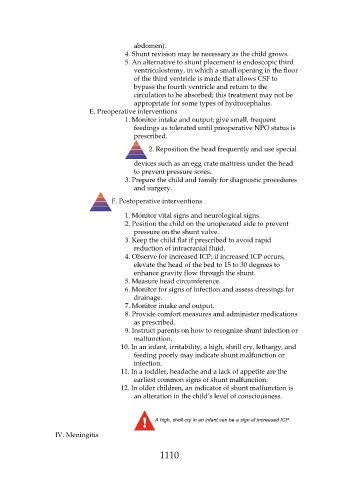Page 1110 - Saunders Comprehensive Review For NCLEX-RN
P. 1110
abdomen).
4. Shunt revision may be necessary as the child grows.
5. An alternative to shunt placement is endoscopic third
ventriculostomy, in which a small opening in the floor
of the third ventricle is made that allows CSF to
bypass the fourth ventricle and return to the
circulation to be absorbed; this treatment may not be
appropriate for some types of hydrocephalus.
E. Preoperative interventions
1. Monitor intake and output; give small, frequent
feedings as tolerated until preoperative NPO status is
prescribed.
2. Reposition the head frequently and use special
devices such as an egg crate mattress under the head
to prevent pressure sores.
3. Prepare the child and family for diagnostic procedures
and surgery.
F. Postoperative interventions
1. Monitor vital signs and neurological signs.
2. Position the child on the unoperated side to prevent
pressure on the shunt valve.
3. Keep the child flat if prescribed to avoid rapid
reduction of intracranial fluid.
4. Observe for increased ICP; if increased ICP occurs,
elevate the head of the bed to 15 to 30 degrees to
enhance gravity flow through the shunt.
5. Measure head circumference.
6. Monitor for signs of infection and assess dressings for
drainage.
7. Monitor intake and output.
8. Provide comfort measures and administer medications
as prescribed.
9. Instruct parents on how to recognize shunt infection or
malfunction.
10. In an infant, irritability, a high, shrill cry, lethargy, and
feeding poorly may indicate shunt malfunction or
infection.
11. In a toddler, headache and a lack of appetite are the
earliest common signs of shunt malfunction.
12. In older children, an indicator of shunt malfunction is
an alteration in the child’s level of consciousness.
A high, shrill cry in an infant can be a sign of increased ICP.
IV. Meningitis
1110

